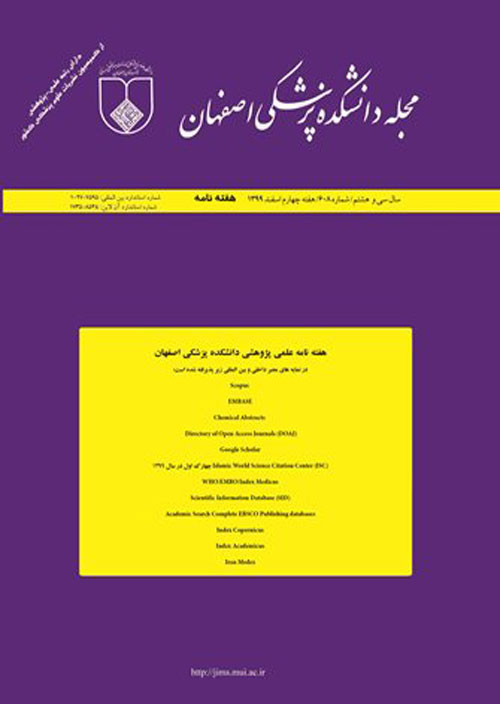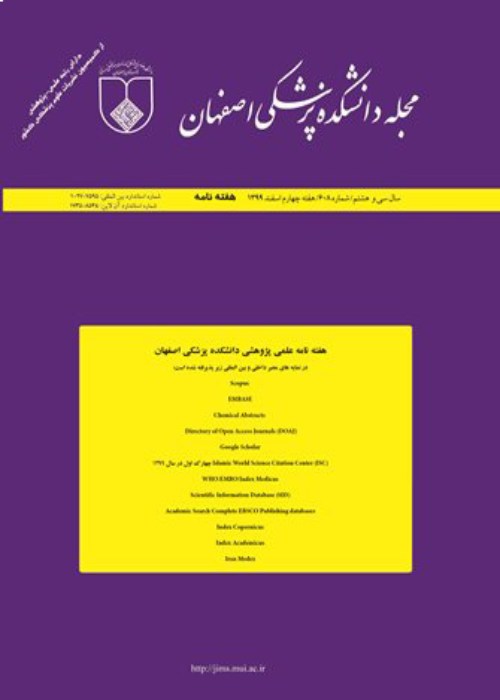فهرست مطالب

مجله دانشکده پزشکی اصفهان
پیاپی 626 (هفته دوم امرداد 1400)
- تاریخ انتشار: 1400/05/12
- تعداد عناوین: 3
-
-
صفحات 363-369
مقدمه :
ناهنجاری های مادرزادی، عامل مهم مرگ و میر نوزادان می باشد. با انجام غربالگری در دوران بارداری و درمان به موقع، می توان از بروز این بیماری ها و مشکلات بعدی ناشی از آن ها، پیش گیری نمود. انجام آزمایش های غربالگری، می تواند باعث ایجاد اضطراب و نگرانی در زنان باردار گردد. مطالعه ی حاضر با هدف تعیین تاثیر آموزش الکترونیک آزمایش های غربالگری جنین بر اضطراب و نگرانی زنان باردار انجام شد.
روش ها:
این پژوهش، یک مطالعه ی نیمه تجربی بود که بر روی 120 زن باردار 9-7 هفته، مراجعه کننده به مراکز بهداشتی- درمانی شهر زاهدان جهت دریافت مراقبت های دوران بارداری به طور تصادفی در قالب دو گروه مورد و شاهد در سال 1399 انجام شد. در گروه مورد، آموزش به صورت انیمیشن 7 دقیقه ای در گروه های 10-5 نفره به صورت حضوری انجام شد و سپس، بر روی گوشی همراه آن ها ارسال گردید. در حالی که گروه شاهد، تنها مراقبت های معمول دوران بارداری را دریافت کردند. قبل و 2 هفته پس از آموزش، اضطراب و نگرانی خانم های باردار به کمک پرسش نامه ی اضطراب Spielberger و نگرانی Cambridge مورد ارزیابی قرار گرفت. داده ها با استفاده از آزمون های آماری 2</sup>χ، Independent t و ANCOVA مورد تجزیه و تحلیل قرار گرفت.
یافته هامیانگین نمره ی اضطراب زنان باردار دو گروه قبل از آموزش الکترونیک معنی دار نبود (920/0 = P). آزمون Independent t نشان داد که پس از اجرای آموزش الکترونیک روش های غربالگری جنین، میانگین نمره ی اضطراب زنان گروه مورد به طور معنی داری از گروه شاهد پایین تر بود (001/0 = P). همچنین، میانگین نمره ی نگرانی در گروه مورد پس از آموزش الکترونیک روش های غربالگری جنین به طور معنی داری کاهش یافت (001/0 = P).
نتیجه گیریمطالعه ی حاضر نشان داد که آموزش الکترونیک به صورت انیمیشن در گروه مورد باعث کاهش معنی دار اضطراب و نگرانی در مادران باردار شده است.
کلیدواژگان: برنامه های غربالگری تشخیصی، معیار ارزیابی اضطراب، حاملگی، آموزش از راه دور، بارداری، انیمیشن -
صفحات 370-375
مقدمه:
بیماری نورومیلیت اپتیکا، از جمله بیماری های التهابی دستگاه عصبی مرکزی است که باعث دمیلینیزاسیون و آسیب آکسونی به ویژه در عصب اپتیک و طناب نخاعی می گردد. با توجه به نقش احتمالی ویتامین D در تنظیم سیستم ایمنی، کمبود این ویتامین شاید بتواند در پاتوژنز و همچنین، شدت بیماری نورومیلیت اپتیکا نقش داشته باشد. هدف از اجرای این مطالعه، مقایسه ی سطح سرمی ویتامین D در مبتلایان به نورومیلیت اپتیکا با گروه شاهد و بررسی ارتباط سطح این ویتامین با میزان ناتوانی و تعداد حملات در طول سال در این بیماران بود.
روش هادر این مطالعه ی مقطعی، 40 نفر از بیماران نورومیلیت اپتیکا و 40 نفر به عنوان گروه شاهد، شرکت کردند. سطح سرمی Vit D (OH) 25 به روش High-performance liquid chromatography (HLPC) اندازه گیری و مقایسه شد. همچنین، متغیرهای بالینی نظیر Expanded disability status scale (EDSS) و Annualized relapse rate (ARR) در بیماران ارزیابی گردید.
یافته هامیانه ی سطح سرمی ویتامین D در بیماران مبتلا به نورومیلیت اپتیکا (20/46 نانوگرم/میلی لیتر) نسبت به گروه شاهد (65/29 نانوگرم/میلی لیتر)، بالاتر بود (001/0 > P). فراوانی عدم کفایت ویتامین D (Vitamin D insufficiency) در گروه شاهد (5/52 درصد) نسبت به بیماران (0/5 درصد)، بالاتر بود. همچنین، میان سطح سرمی ویتامین D با Body mass index (BMI)، EDSS و ARR در بیماران، ارتباط آماری معنی داری وجود نداشت.
نتیجه گیریمطابق یافته های مطالعه ی حاضر، همراهی قابل توجهی میان کمبود ویتامین D و بیماری نورومیلیت اپتیکا وجود نداشت.
کلیدواژگان: نورومیلیت اپتیکا، ویتامین D، بیماریهای دستگاه عصبی مرکزی، بیماریهای دمیلینیزان -
صفحات 376-383
مقدمه :
کباب کردن یکی از سنتی ترین شیوه های طبخ مواد غذایی به ویژه گوشت است که سبب تولید هیدروکربن های آروماتیک چند حلقه ای و آمین های آروماتیک هتروسیکلیک می گردد. آژانس بین المللی تحقیقات سرطان بیشتر این ترکیبات، به ویژه بنزو (آ) پیرن یا فنیل ایمیدازوپیریدین را برای انسان سرطان زا دانسته است. مقادیر این ترکیبات در کباب، به طور کامل به شیوه ی کباب کردن بستگی دارد. هدف از انجام مطالعه ی مروری حاضر، ارایه ی شواهد و راهکارهایی برای کاهش تولید این ترکیبات در هنگام کباب کردن بود.
روش هامطالعه ی مروری حاضر شامل مقالات جستجو شده در پایگاه های اطلاعاتی ملی و بین المللی تا دسامبر سال 2020 بود. معیار ورود به مطالعه شامل مقالات اصیل پژوهشی بود که به مقایسه ی عوامل قابل کنترل در غلظت بنزو (آ) پیرن یا فنیل ایمیدازوپیریدین تولید شده در کباب پرداخته بودند.
یافته هانتایج نشان داد میزان آلودگی به ترکیبات بنزو (آ) پیرن و فنیل ایمیدازوپیریدین گوشت های کباب شده، به طور کامل به عواملی نظیر درجه ی حرارت و مدت زمان کباب کردن، نوع سوخت مصرفی، فاصله از منبع گرما، چاشنی ها و میزان چربی گوشت بستگی دارد.
نتیجه گیریکاهش دریافت هیدروکربن های آروماتیک چند حلقه ای و آمین های آروماتیک هتروسیکلیک از کباب، از طریق کاهش مدت زمان و درجه ی حرارت کباب کردن، استفاده از گاز به جای زغال و چوب، افزایش فاصله ی گوشت از آتش، استفاده از چاشنی ها، استفاده از گوشت های بسیار کم چرب و حذف پوست از مرغ، امکان پذیر می باشد.
کلیدواژگان: هیدروکربنهای آروماتیک پلیسیکلیک، سرطانزا، غذا، گوشت
-
Pages 363-369Background
Congenital malformations are important causes of neonatal mortality and morbidity. They can be prevented by performing screening tests and accurate treatment schedules in pregnancy period. Screening tests may cause anxiety in pregnant women. The aim of this study was to determine the effects of e-learning about fetal screening tests on anxiety in pregnant women.
MethodsThis was a quasi-experimental study performed on 120 pregnant women of 7 to 9 weeks gestational age who referred to health centers in Zahedan City, Iran, during the year 2020, to receive prenatal care randomly in two groups of intervention and control. In the intervention group, the training was conducted in the form of 7-minute animation in groups of 5-10 people; the animation was sent to their mobile cells as well. While the control group received only routine pregnancy care. Before and 2 weeks after training, anxiety and worrying of pregnant women were assessed using Spielberger Anxiety Questionnaire and Cambridge Worry Scale (CWS). Data were analyzed using chi-square, independent t, and ANCOVA tests.
FindingsThe defiance of mean anxiety score of pregnant women in the two groups before e-learning was not significant (P = 0.920). Independent t-test showed that after performing e-learning about fetal screening tests, the mean score of anxiety in women in the intervention group was significantly lower than the control group (P = 0.001). Moreover, the mean score of anxiety in the intervention group after e-learning of fetal screening tests decreased significantly (P = 0.001).
ConclusionThe study showed that e-learning in the form of animation in the intervention group significantly reduced anxiety and worrying in pregnant mothers.
Keywords: Diagnostic screening programs, Test anxiety scale, Pregnancy, Distance education, Animation -
Pages 370-375Background
Neuromyelitis optica is one of the inflammatory diseases of the central nervous system (CNS) that causes demyelination and axonal injury, especially in optic nerve and spinal cord. Considering the immunoregulatory function of vitamin D, deficiency of this vitamin may play a role in the pathogenesis as well as the severity of neuromylitis optica. The aim of this study was to compare the serum level of vitamin D in patients with neuromylitis optica and control group, and to investigate the relationship between the level of this vitamin and disability and number of attacks during the year in these patients.
MethodsIn this cross-sectional study, 40 patients with neuromylitis optica and 40 healthy individuals as a control group participated. Serum level of 25 (OH) vitamin D was measured using high-performance liquid chromatography (HLPC) method and compared. Clinical parameters such as Expanded Disability Status Scale (EDSS) and Annualized Relapse Rate (ARR) were also evaluated in patients.
FindingsThe median of serum levels of vitamin D was higher in patients (46.2 ng/ml) than in controls (29.65 ng/ml) (P < 0.001). The prevalence of Vitamin D insufficiency in the control group (52.5%) was higher than this prevalence in patients (5.0%). Moreover, there was no significant relationship between serum vitamin D levels with body mass index (BMI), EDSS, and ARR in patients.
ConclusionAccording to our findings, there was no significant association between vitamin D deficiency and neuromylitis optica disease.
Keywords: Neuromyelitis optica, Vitamin D, Central nervous system diseases, Demyelinating diseases -
Pages 376-383Background
Grilling is one of the most traditional methods of cooking food, especially meat, which leads to the production of polycyclic aromatic hydrocarbons (PAHs) and heterocyclic aromatic amines (HAAs). International Agency for Research on Cancer has mentioned most of these compound, particular Benzo[a]pyrene and Phenyl imidazo pyridine, as carcinogenic to humans. The amount of the PAHs and HAAs in Kebab completely depends on the grilling method. The current review aimed to provide evidence and interventions to reduce the production of the PAHs and HAAs during grilling.
MethodsThis literature review consisted of articles searched in national and international databases up to December 2020. The inclusion criteria were original studies comparing controllable factors in the concentration of Benzo[a]pyrene and Phenyl imidazo pyridine produced in the Kebab.
ResultsThe results of the current review showed that the level of Benzo[a]pyrene and Phenyl imidazo pyridine produced in the Kebab completely depened on factors including grilling temperature and duration, type of fuel, distance from the heat source, condiments, and the amount of fat in the meat.
ConclusionReducing of the PAHs and HAAs intake from Kebab can be achieved through reducing grilling temperature and durations, using gas instead of charcoal and wood, increasing the distance of meat from the fire, using condiments, using low-fat meats, and removing the skin from chicken.
Keywords: Polycyclic aromatic hydrocarbons, Carcinogens, Foods, Meat


